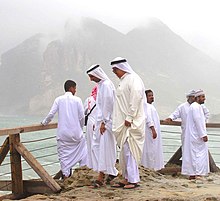Thawb
The thawb (from Arabic ثوب, DMG ṯaub ‚Gewand '), in Oman , Kuwait , Iraq and Qatar Dischdascha (دشداشة, DMG dišdāša , also Dishdasha ), in the United Arab Emirates Kandura (كندورة, DMG kandūra ), in Saudi Arabia Qamis (قميص, DMG Qamis even Khameez ) or in Libya Suriyah called, is an airy, ankle-length, long-sleeved usually, tree woolen (rare woolen) and mostly white robe, traditionally in the desert regions of the Arabian Peninsula worn and various neighboring areas mainly by men .
The collar and sleeve shapes vary from one region to another:
- In Oman , the dishdascha is worn without a collar and without a cuff . A tassel that can be perfumed dangles from the round neckline . The fashionable Omani likes to wear the dishdascha in pastel tones and thus differs from the male inhabitants of neighboring Arab countries, in which the white dishdascha predominates. At the Dischdascha one wears a kofia as headgear (as can be seen with the man on the far right in the picture). For more formal occasions such as B. traditional celebrations or family celebrations, however, the turban is worn with the Dischdascha (similar to how a tie is worn with a suit in Western culture ). In addition, the khanjar is created.
- In Qatar, Dubai and Abu Dhabi , the dishdashas or kanduras are often worn with collars, cuffs and cufflinks , based on Western culture .
Web links
Commons : Thawb - collection of images, videos and audio files
